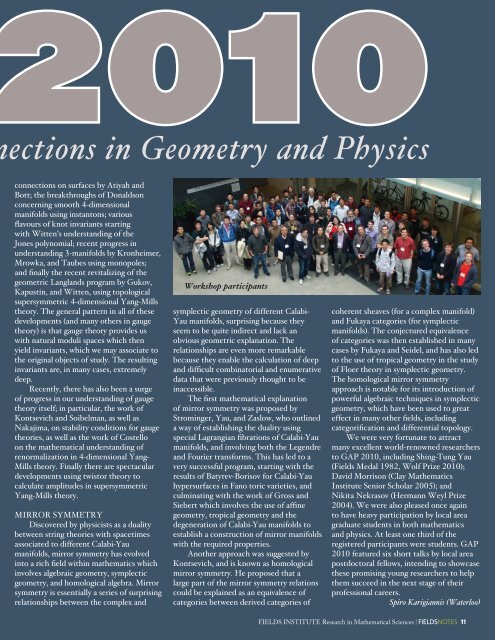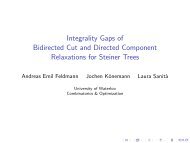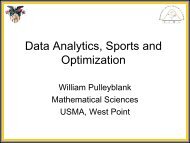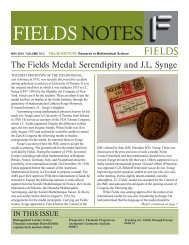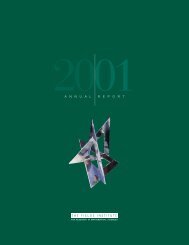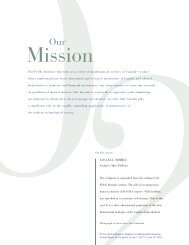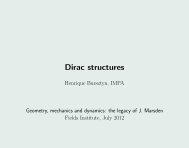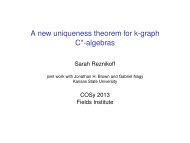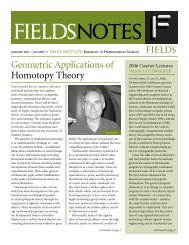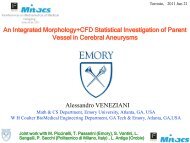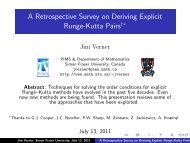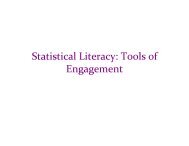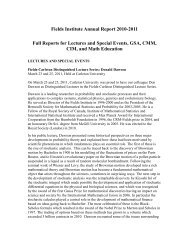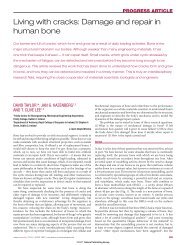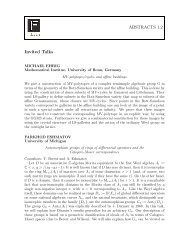SCIENTIFIC ACTIVITIES - Fields Institute - University of Toronto
SCIENTIFIC ACTIVITIES - Fields Institute - University of Toronto
SCIENTIFIC ACTIVITIES - Fields Institute - University of Toronto
Create successful ePaper yourself
Turn your PDF publications into a flip-book with our unique Google optimized e-Paper software.
010<br />
ections in Geometry and Physics<br />
connections on surfaces by Atiyah and<br />
Bott; the breakthroughs <strong>of</strong> Donaldson<br />
concerning smooth 4-dimensional<br />
manifolds using instantons; various<br />
flavours <strong>of</strong> knot invariants starting<br />
with Witten’s understanding <strong>of</strong> the<br />
Jones polynomial; recent progress in<br />
understanding 3-manifolds by Kronheimer,<br />
Mrowka, and Taubes using monopoles;<br />
and finally the recent revitalizing <strong>of</strong> the<br />
geometric Langlands program by Gukov,<br />
Kapustin, and Witten, using topological<br />
supersymmetric 4-dimensional Yang-Mills<br />
theory. The general pattern in all <strong>of</strong> these<br />
developments (and many others in gauge<br />
theory) is that gauge theory provides us<br />
with natural moduli spaces which then<br />
yield invariants, which we may associate to<br />
the original objects <strong>of</strong> study. The resulting<br />
invariants are, in many cases, extremely<br />
deep.<br />
Recently, there has also been a surge<br />
<strong>of</strong> progress in our understanding <strong>of</strong> gauge<br />
theory itself; in particular, the work <strong>of</strong><br />
Kontsevich and Soibelman, as well as<br />
Nakajima, on stability conditions for gauge<br />
theories, as well as the work <strong>of</strong> Costello<br />
on the mathematical understanding <strong>of</strong><br />
renormalization in 4-dimensional Yang-<br />
Mills theory. Finally there are spectacular<br />
developments using twistor theory to<br />
calculate amplitudes in supersymmetric<br />
Yang-Mills theory.<br />
MIRROR SYMMETRY<br />
Discovered by physicists as a duality<br />
between string theories with spacetimes<br />
associated to different Calabi-Yau<br />
manifolds, mirror symmetry has evolved<br />
into a rich field within mathematics which<br />
involves algebraic geometry, symplectic<br />
geometry, and homological algebra. Mirror<br />
symmetry is essentially a series <strong>of</strong> surprising<br />
relationships between the complex and<br />
Workshop participants<br />
symplectic geometry <strong>of</strong> different Calabi-<br />
Yau manifolds, surprising because they<br />
seem to be quite indirect and lack an<br />
obvious geometric explanation. The<br />
relationships are even more remarkable<br />
because they enable the calculation <strong>of</strong> deep<br />
and difficult combinatorial and enumerative<br />
data that were previously thought to be<br />
inaccessible.<br />
The first mathematical explanation<br />
<strong>of</strong> mirror symmetry was proposed by<br />
Strominger, Yau, and Zaslow, who outlined<br />
a way <strong>of</strong> establishing the duality using<br />
special Lagrangian fibrations <strong>of</strong> Calabi-Yau<br />
manifolds, and involving both the Legendre<br />
and Fourier transforms. This has led to a<br />
very successful program, starting with the<br />
results <strong>of</strong> Batyrev-Borisov for Calabi-Yau<br />
hypersurfaces in Fano toric varieties, and<br />
culminating with the work <strong>of</strong> Gross and<br />
Siebert which involves the use <strong>of</strong> affine<br />
geometry, tropical geometry and the<br />
degeneration <strong>of</strong> Calabi-Yau manifolds to<br />
establish a construction <strong>of</strong> mirror manifolds<br />
with the required properties.<br />
Another approach was suggested by<br />
Kontsevich, and is known as homological<br />
mirror symmetry. He proposed that a<br />
large part <strong>of</strong> the mirror symmetry relations<br />
could be explained as an equivalence <strong>of</strong><br />
categories between derived categories <strong>of</strong><br />
coherent sheaves (for a complex manifold)<br />
and Fukaya categories (for symplectic<br />
manifolds). The conjectured equivalence<br />
<strong>of</strong> categories was then established in many<br />
cases by Fukaya and Seidel, and has also led<br />
to the use <strong>of</strong> tropical geometry in the study<br />
<strong>of</strong> Floer theory in symplectic geometry.<br />
The homological mirror symmetry<br />
approach is notable for its introduction <strong>of</strong><br />
powerful algebraic techniques in symplectic<br />
geometry, which have been used to great<br />
effect in many other fields, including<br />
categorification and differential topology.<br />
We were very fortunate to attract<br />
many excellent world-renowned researchers<br />
to GAP 2010, including Shing-Tung Yau<br />
(<strong>Fields</strong> Medal 1982, Wolf Prize 2010);<br />
David Morrison (Clay Mathematics<br />
<strong>Institute</strong> Senior Scholar 2005); and<br />
Nikita Nekrasov (Hermann Weyl Prize<br />
2004). We were also pleased once again<br />
to have heavy participation by local area<br />
graduate students in both mathematics<br />
and physics. At least one third <strong>of</strong> the<br />
registered participants were students. GAP<br />
2010 featured six short talks by local area<br />
postdoctoral fellows, intending to showcase<br />
these promising young researchers to help<br />
them succeed in the next stage <strong>of</strong> their<br />
pr<strong>of</strong>essional careers.<br />
Spiro Karigiannis (Waterloo)<br />
FIELDS INSTITUTE Research in Mathematical Sciences | FIELDSNOTES 11


